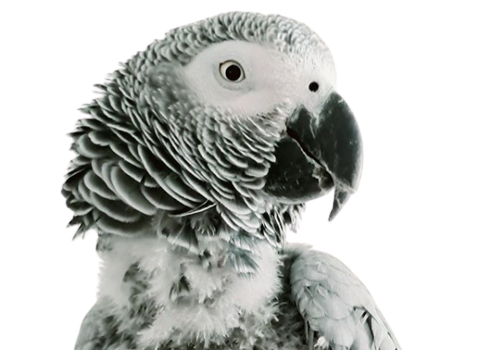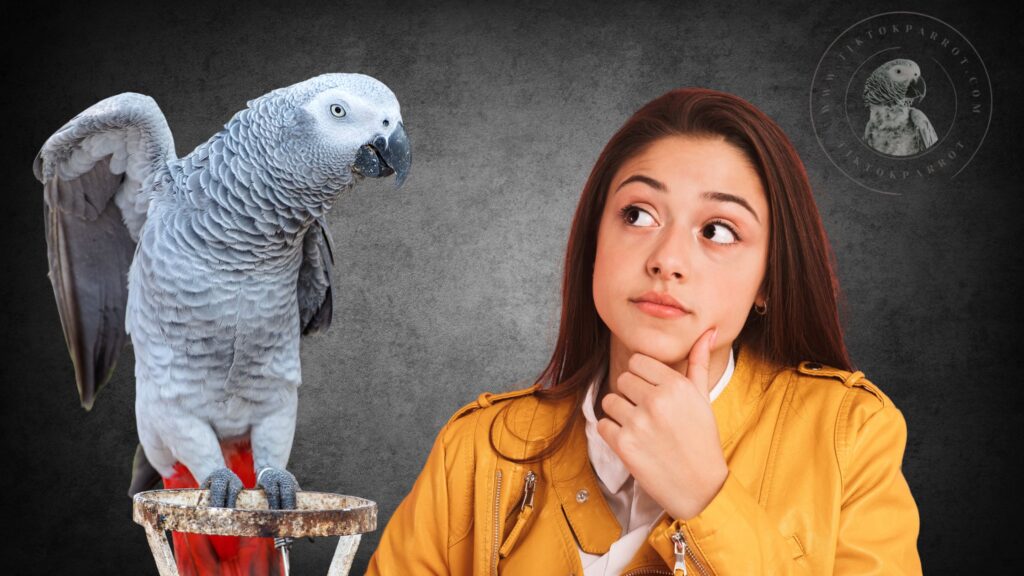Living with an African grey parrot can be a fascinating adventure, but sometimes it feels like trying to solve a puzzle! Those captivating brown eyes seem to hold a secret, leaving you wondering what’s really going on in their mind. While they may be quick-witted and playful, their emotions can be as delicate as a whisper.
Don’t worry, fellow parrot parents! This guide is here to help you crack the code, turning your African grey’s subtle signals into clear and understandable messages. Get ready to deepen your connection and become an expert in understanding your feathered friend!
Unlock the secrets of your African Grey Parrot’s behavior! From mimicry to body language, learn to decode their quirks.
Table of Contents
First things first, let’s talk body language. Much like us humans, African Greys are master communicators when it comes to non-verbal cues. From fluffed feathers to subtle head tilts, every movement tells a story. For instance, did you know that a rapid tapping of the beak could indicate excitement or curiosity? It’s like they’re Morse coding their emotions to us!

Now, let’s address the elephant in the room (or should I say, the parrot in the aviary?) – the infamous feather plucking. If your African Grey is partaking in a bit of DIY grooming, it could be a sign of stress or boredom. Think of it as their version of stress-eating a tub of ice cream – except with feathers. Cue the melodramatic parrot sigh.
But don’t worry, for there are solutions! Enrichment activities like puzzle toys and foraging opportunities can keep your feathered friend’s mind engaged and their beak out of trouble. Plus, it’s a win-win situation – you get to witness your parrot’s genius problem-solving skills, and they get a mental workout worthy of Mensa.
Now, let’s talk about the notorious mimicry skills of African Greys. From mimicking your phone’s ringtone to perfectly imitating your significant other’s laughter (much to their chagrin), these birds are the true chameleons of the avian world. It’s like having a feathered impressionist living in your home – move over, Pablo Parrotcasso!
But here’s the kicker – mimicry isn’t just for entertainment purposes. It’s also a form of bonding and communication for our African Grey pals. So, the next time your parrot belts out a flawless rendition of your morning alarm, take it as a sign of affection. Who needs a wake-up call when you’ve got a parrot alarm clock? 🙂
The Eyes Have It: A Window to the Soul (or at least the Beak)

African Greys wear their emotions on their sleeves – well, maybe on their eyeballs. Here’s a crash course in parrot peepers:
- Pinpoint pupils: This usually signifies excitement or alertness. Think of your parrot as a furry feline with a taste for sunflower seeds instead of string.
- Dilated pupils: Just like us, dilated pupils in parrots can indicate fear or startlement. Did you accidentally step on a rogue Lego brick near the cage? This might be the culprit.
- The “Side-Eye”: The undisputed champion of passive aggression in the avian kingdom. This sidelong glance can convey anything from mild annoyance to full-blown “I’m plotting your demise” territory. Proceed with caution, my friend.
Beak Bonanza: Beyond Just a Pretty Face
An African Grey’s beak is more than just a chomping machine; it’s a multi-purpose communication tool. Here’s how to translate those beak-based messages:
- Gentle preening: This is a sign of affection and bonding. Basically, your parrot is giving you a feathery high-five.
- Nipping: Ouch! This can indicate anything from playfulness to frustration. If your parrot is nipping hard, it’s best to disengage and offer a more appropriate chew toy.
- Beak grinding: This rhythmic clicking sound often signifies contentment. Imagine it as your parrot’s way of purring.
The Soundtrack of Your Life: More Than Just Squawks
African Greys are vocal powerhouses with a repertoire that would put a karaoke champion to shame. Let’s explore the meaning behind the melodies:
- Happy chirps and whistles: These are your basic “good morning, sunshine” greetings. Your parrot is simply happy to see you (or maybe just excited for breakfast).
- Loud screeches: This could indicate anything from fear to boredom. Think of it as your parrot’s smoke detector – a sign that something needs your attention.
- Talking: Ah, the pièce de résistance! When your African Grey mimics your voice or everyday sounds, it’s not just showing off. It’s a sign of intelligence, bonding, and a desire to interact.
Body Language: A Tail Tells All
Your African Grey might not be fluent in sign language, but its body language speaks volumes.
- Raised crest: This can indicate excitement, alertness, or even aggression. Pay attention to other cues to decipher the exact message.
- Tail bobbing: A happy dance! Your parrot is feeling content and playful.
- Fluffed feathers: This can signal fear, stress, or illness. If your parrot is puffed up and withdrawn, it’s best to consult a veterinarian.
Remember: I always say that every parrot is an individual, and their communication style can vary. The key is to observe your African Grey’s behavior in context and learn its unique way of expressing itself.
My Closing Thoughts
Living with an African Grey parrot is like having a feathered roommate with a serious case of wanderlust and a vocabulary that would make a sailor blush. These brainy birds are notorious for their impressive mimicry and sharp wit, but sometimes their behavior can leave you scratching your head and wondering, “What’s going on in that beautiful grey noggin?”
By understanding your African Grey’s communication cues, you can build a deeper bond with your feathered friend. Think of it as an ongoing conversation, filled with funny squawks, playful nips, and the occasional side-eye. With patience, dedication, and a healthy dose of humor, you’ll be a master decoder of your parrot’s messages in no time.
I hope, this guide has empowered you to crack the code of your parrot’s mysterious language, transforming you into a true animal whisperer – a Dr. Doolittle for your beloved feathered companion! With this newfound understanding, you’ll be able to decode their subtle cues, respond to their needs, and strengthen your unbreakable bond. Happy communicating!
This is no the end, there is still so much which you can learn more about African greys body language and behaviors in this category.
I would love to hear from you! Share your experiences with your African Grey’s communication style in the comments below. What are some of the funniest or most endearing ways your parrot expresses itself?
If you found this blog helpful, It would be great if you could share it with your family and friends who might find it useful as well.
You might like to check this out as well 🙂
African Grey Behavior: Understanding your Pets
Top 10 Toys to Keep Your Parrot Entertained and Engaged
The Secret Grooming Habits of an African Grey’s Head Feathers
Poop or Perch: Understanding Your Parrot’s Bathroom Body Language
How Do We Take Care of an African Parrot Grey’s Health?
How do you handle African Grey Parrot?
For more useful content about African grey parrots, you can subscribe my site with your email to get notification upon publishing a new blog, the subscribe box you can see on the right side of this page. Also if you get an alert on your web browser while browsing my site, allow it and that will also give you an alert whenever I publish a new blog. 🙂
Stay safe and much love!



